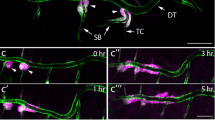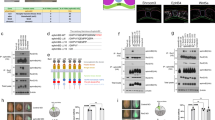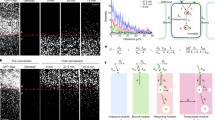Abstract
Networks of epithelial and endothelial tubes are essential for the function of organs such as the lung, kidney and vascular system. The sizes and shapes of these tubes are highly regulated to match their individual functions. Defects in tube size can cause debilitating diseases such as polycystic kidney disease and ischaemia1,2. It is therefore critical to understand how tube dimensions are regulated. Here we identify the tyrosine kinase Src as an instructive regulator of epithelial-tube length in the Drosophila tracheal system. Loss-of-function Src42 mutations shorten tracheal tubes, whereas Src42 overexpression elongates them. Surprisingly, Src42 acts distinctly from known tube-size pathways and regulates both the amount of apical surface growth and, with the conserved formin dDaam, the direction of growth. Quantitative three-dimensional image analysis reveals that Src42- and dDaam-mutant tracheal cells expand more in the circumferential than the axial dimension, resulting in tubes that are shorter in length—but larger in diameter—than wild-type tubes. Thus, Src42 and dDaam control tube dimensions by regulating the direction of anisotropic growth, a mechanism that has not previously been described.
This is a preview of subscription content, access via your institution
Access options
Subscribe to this journal
Receive 12 print issues and online access
$209.00 per year
only $17.42 per issue
Buy this article
- Purchase on Springer Link
- Instant access to full article PDF
Prices may be subject to local taxes which are calculated during checkout





Similar content being viewed by others
References
Harris, P. C. & Torres, V. E. Polycystic kidney disease. Annu. Rev. Med. 60, 321–337 (2009).
Requena, L. & Sangueza, O. P. Cutaneous vascular anomalies. Part I. Hamartomas, malformations, and dilation of preexisting vessels. J. Am. Acad. Dermatol. 37, 523–549; quiz 549-552 (1997).
Beitel, G. J. & Krasnow, M. A. Genetic control of epithelial tube size in the Drosophila tracheal system. Development 127, 3271–3282 (2000).
Samakovlis, C. et al. Development of the Drosophila tracheal system occurs by a series of morphologically distinct but genetically coupled branching events. Development 122, 1395–1407 (1996).
Laprise, P. et al. Epithelial polarity proteins regulate Drosophila tracheal tube size in parallel to the luminal matrix pathway. Curr. Biol. 20, 55–61 (2010).
Wu, V. M., Schulte, J., Hirschi, A., Tepass, U. & Beitel, G. J. Sinuous is a Drosophila claudin required for septate junction organization and epithelial tube size control. J. Cell Biol. 164, 313–323 (2004).
Chung, S. et al. Serrano (sano) functions with the planar cell polarity genes to control tracheal tube length. PLoS Genet. 5, e1000746 (2009).
Tonning, A. et al. A transient luminal chitinous matrix is required to model epithelial tube diameter in the Drosophila trachea. Dev. Cell 9, 423–430 (2005).
Moussian, B. et al. Drosophila Knickkopf and Retroactive are needed for epithelial tube growth and cuticle differentiation through their specific requirement for chitin filament organization. Development 133, 163–171 (2006).
Araujo, S. J., Aslam, H., Tear, G. & Casanova, J. mummy/cystic encodes an enzyme required for chitin and glycan synthesis, involved in trachea, embryonic cuticle and CNS development—analysis of its role in Drosophila tracheal morphogenesis. Dev. Biol. 288, 179–193 (2005).
Luschnig, S., Batz, T., Armbruster, K. & Krasnow, M. A. Serpentine and vermiform encode matrix proteins with chitin binding and deacetylation domains that limit tracheal tube length in Drosophila. Curr. Biol. 16, 186–194 (2006).
Wang, S. et al. Septate-junction-dependent luminal deposition of chitin deacetylases restricts tube elongation in the Drosophila trachea. Curr. Biol. 16, 180–185 (2006).
Paul, S. M., Ternet, M., Salvaterra, P. M. & Beitel, G. J. The Na+/K+ ATPase is required for septate junction function and epithelial tube-size control in the Drosophila tracheal system. Development 130, 4963–4974 (2003).
Behr, M., Riedel, D. & Schuh, R. The claudin-like megatrachea is essential in septate junctions for the epithelial barrier function in Drosophila. Dev. Cell 5, 611–620 (2003).
Nelson, K. S., Furuse, M. & Beitel, G. J. The Drosophila Claudin Kune-kune is required for septate junction organization and tracheal tube size control. Genetics 185, 831–839 (2010).
Paul, S. M., Palladino, M. J. & Beitel, G. J. A pump-independent function of the Na, K-ATPase is required for epithelial junction function and tracheal tube-size control. Development 134, 147–155 (2007).
Thomas, S. M. & Brugge, J. S. Cellular functions regulated by Src family kinases. Annu Rev Cell Dev. Biol. 13, 513–609 (1997).
Marx, M., Warren, S. L. & Madri, J. A. pp60 (c-src) modulates microvascular endothelial phenotype and in vitro angiogenesis. Exp. Mol. Pathol. 70, 201–213 (2001).
Sweeney, W. E. Jr, von Vigier, R. O., Frost, P. & Avner, E. D. Src inhibition ameliorates polycystic kidney disease. J. Am. Soc. Nephrol. 19, 1331–1341 (2008).
Schwartzberg, P. L. et al. Rescue of osteoclast function by transgenic expression of kinase-deficient Src in src−/− mutant mice. Genes Dev. 11, 2835–2844 (1997).
Kaplan, K. B., Swedlow, J. R., Morgan, D. O. & Varmus, H. E. c-Src enhances the spreading of src−/− fibroblasts on fibronectin by a kinase-independent mechanism. Genes Dev. 9, 1505–1517 (1995).
Pedraza, L. G., Stewart, R. A., Li, D. M. & Xu, T. Drosophila Src-family kinases function with Csk to regulate cell proliferation and apoptosis. Oncogene 23, 4754–4762 (2004).
Shindo, M. et al. Dual function of Src in the maintenance of adherens junctions during tracheal epithelial morphogenesis. Development 135, 1355–1364 (2008).
Shiga, Y., Tanaka-Matakatsu, M. & Hayashi, S. A nuclear GFP/β-galactosidase fusion protein as a marker for morphogenesis in living Drosophila. Dev. Growth Differ. 38, 99–106 (1996).
Takahashi, M., Takahashi, F., Ui-Tei, K., Kojima, T. & Saigo, K. Requirements of genetic interactions between Src42A, armadillo and shotgun, a gene encoding E-cadherin, for normal development in Drosophila. Development 132, 2547–2559 (2005).
Padash-Barmchi, M., Browne, K., Sturgeon, K., Jusiak, B. & Auld, V. J. Control of Gliotactin localization and levels by tyrosine phosphorylation and endocytosis is necessary for survival of polarized epithelia. J. Cell Sci. 123, 4052–4062 (2010).
LeClaire, L. L. 3rd, Baumgartner, M., Iwasa, J. H., Mullins, R. D. & Barber, D. L. Phosphorylation of the Arp2/3 complex is necessary to nucleate actin filaments. J. Cell Biol. 182, 647–654 (2008).
Aspenstrom, P., Richnau, N. & Johansson, A. S. The diaphanous-related formin DAAM1 collaborates with the Rho GTPases RhoA and Cdc42, CIP4 and Src in regulating cell morphogenesis and actin dynamics. Exp. Cell Res. 312, 2180–2194 (2006).
Matusek, T. et al. The Drosophila formin DAAM regulates the tracheal cuticle pattern through organizing the actin cytoskeleton. Development 133, 957–966 (2006).
Matusek, T. et al. Formin proteins of the DAAM subfamily play a role during axon growth. J. Neurosci. 28, 13310–13319 (2008).
Tominaga, T. et al. Diaphanous-related formins bridge Rho GTPase and Src tyrosine kinase signaling. Mol. Cell 5, 13–25 (2000).
Young, K. G. & Copeland, J. W. Formins in cell signaling. Biochim. Biophys. Acta 1803, 183–190 (2010).
Segalen, M. & Bellaiche, Y. Cell division orientation and planar cell polarity pathways. Semin. Cell Dev. Biol. 20, 972–977 (2009).
Ang, S. F., Zhao, Z. S., Lim, L. & Manser, E. DAAM1 is a formin required for centrosome re-orientation during cell migration. PLoS One 5, e13064 (2010).
O’Reilly, A. M. et al. Csk differentially regulates Src64 during distinct morphological events in Drosophila germ cells. Development 133, 2627–2638 (2006).
Ward, R. E. t., Lamb, R. S. & Fehon, R. G. A conserved functional domain of Drosophila coracle is required for localization at the septate junction and has membrane-organizing activity. J. Cell Biol. 140, 1463–1473 (1998).
Abramoff, M. D., Magalhaes, P. J. & Ram, S. J. Image Processing with ImageJ. Biophoton. Int. 11, 36–42 (2004).
Maurer, C. R., Qi, R. & Raghavan, V. A linear time algorithm for computing exact euclidean distance transforms of binary images in arbitrary dimensions. IEEE Trans. Pattern Anal. Machine Intelligence 25, 265–270 (2003).
Lorensen, W. E. & Cline, H. E. SIGGRAPH ’87: Proceedings of the 14th annual conference on computer graphics and interactive techniques 163–169 (ACM, 1987).
Vincent, L. & Soille, P. Watersheds in digital spaces: an efficient algorithm based on immersion simulations. IEEE Trans. Pattern Anal. Machine Intelligence 13, 583–598 (1991).
Acknowledgements
We thank M. Zeeb and E. Lammert for sharing unpublished results and comments on the manuscript, R. Carthew, S. Hilgenfeldt and A. Dudley for discussions, Bill Russin and the Northwestern Biological Imaging Facility for imaging support, S. Hayashi, A. O’Reilly, T. Xu, the Bloomington Stock Center and the Developmental Studies Hybridoma Bank for fly stocks and reagents, M. Singh for technical advice and R. Robbins, T. Helenius and T. Krupinski for comments on the manuscript. This work was supported by a predoctoral fellowship from the National Institutes of Health (NIH) Cellular and Molecular Basis of Disease training grant (T32 GM008061 to K.S.N.), a Malkin Scholar Award (to K.S.N.), an Achievement Rewards for College Scientists (ARCS) Award (to K.S.N.), a grant from the Northwestern University Alumni Association (to G.J.B.), NIH grant P50 GM 071508, principal investigator D. Botstein (Z.K. and M.K.), and Hungarian Scientific Research Fund (OTKA) grant K 82039 (to J.M.).
Author information
Authors and Affiliations
Contributions
K.S.N. carried out all experiments, Z.K. generated and analysed individual dorsal-trunk cell quantifications, I.M. generated the UAS–Flag–dDaam construct and the dDaam antibody, K.S.N., Z.K., M.K. and G.J.B. designed and interpreted the experiments and K.S.N., Z.K., J.M., M.K. and G.J.B. wrote the paper.
Corresponding author
Ethics declarations
Competing interests
The authors declare no competing financial interests.
Supplementary information
Supplementary Information
Supplementary Information (PDF 1988 kb)
Supplementary Table 1
Supplementary Information (XLSX 41 kb)
Rights and permissions
About this article
Cite this article
Nelson, K., Khan, Z., Molnár, I. et al. Drosophila Src regulates anisotropic apical surface growth to control epithelial tube size. Nat Cell Biol 14, 518–525 (2012). https://doi.org/10.1038/ncb2467
Received:
Accepted:
Published:
Issue Date:
DOI: https://doi.org/10.1038/ncb2467
This article is cited by
-
An allosteric switch between the activation loop and a c-terminal palindromic phospho-motif controls c-Src function
Nature Communications (2023)
-
Sex dependent effect of maternal e-nicotine on F1 Drosophila development and airways
Scientific Reports (2021)
-
PTPN3 suppresses lung cancer cell invasiveness by counteracting Src-mediated DAAM1 activation and actin polymerization
Oncogene (2019)
-
WASH phosphorylation balances endosomal versus cortical actin network integrities during epithelial morphogenesis
Nature Communications (2019)
-
Extracellular matrix stiffness cues junctional remodeling for 3D tissue elongation
Nature Communications (2019)



